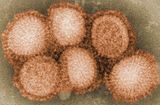
One of the most hazardous ingredients in potato chips is not intentionally added, but rather is a byproduct of the processing.
To understand the nature of Pringles and other stackable chips, forget the notion that they come from actual potatoes in any recognizable way.
The Pringles Company (in an effort to avoid taxes levied against “luxury foods” like chips in the UK) once even argued that the potato content of their chips was so low that they are technically not even potato chips.
So if they’re not made of potatoes, what are they exactly? The process begins with slurry of rice, wheat, corn, and potato flakes that are pressed into shape.
This dough-like substance is then rolled out into an ultra-thin sheet cut into chip-cookies by a machine.
According to io9:
“The chips move forward on a conveyor belt until they’re pressed onto molds, which give them the curve that makes them fit into one another.
Those molds move through boiling oil … Then they’re blown dry, sprayed with powdered flavors, and at last, flipped onto a slower-moving conveyor belt in a way that allows them to stack.
From then on, it’s into the cans … and off towards the innocent mouths of the consumers.”
I suspect nearly everyone reading this likely enjoys the taste of potato chips. However, they are clearly one of the most toxic processed foods you can eat—whether they’re made from actual potato shavings or not.
Potato Chips are Loaded with Cancer-Causing Chemical
One of the most hazardous ingredients in potato chips is not intentionally added, but rather is a byproduct of the processing.
Acrylamide, a cancer-causing and potentially neurotoxic chemical, is created when carbohydrate-rich foods are cooked at high temperatures, whether baked, fried, roasted or toasted. Some of the worst offenders include potato chips and French fries, but many foods cooked or processed at temperatures above 212°F (100°C) may contain acrylamide. As a general rule, the chemical is formed when food is heated enough to produce a fairly dry and brown/yellow surface. Hence, it can be found in:
Potatoes: chips, French fries and other roasted or fried potato foods
- Grains: bread crust, toast, crisp bread, roasted breakfast cereals and various processed snacks
- Coffee; roasted coffee beans and ground coffee powder. Surprisingly, coffee substitutes based on chicory actually contains 2-3 times MORE acrylamide than real coffee
Beware: Baked Chips May Be WORSE than Fried!
If you think you can avoid the health risks of potato chips by choosing baked varieties, which are typically advertised as being “healthier,” think again. Remember that acrylamide is formed not only when foods are fried or broiled, but also when they are baked. And according to U.S. Food and Drug Administration (FDA) data on acrylamide levels in foods, baked chips may contain more than three times the level of acrylamide as regular chips!
Interestingly, the same trend holds true for other foods, too, which suggests that baking processed potatoes at high temperature may be one of the worst ways to cook them. For instance, according to the FDA’s data, Ore Ida Golden Fries contained 107 ppb of acrylamide in the regular fried version and 1,098 when baked. So remember, ALL potato chips contain acrylamide, regardless of whether they are natural or not; baked or fried. Likewise, they will ALL influence your insulin levels in a very negative way.
Acrylamide is Not the Only Danger
Acrylamide is not the only dangerous genotoxic compound formed when food is heated to high temperatures.
A three-year long EU project, known as Heat-Generated Food Toxicants (HEATOX), whose findings were published at the end of 2007, found there are more than 800 heat-induced compounds, of which 52 are potential carcinogens. In addition to their finding that acrylamide does pose a public health threat, the HEATOX scientists also discovered that you’re far less likely to ingest dangerous levels of the toxin when you eat home-cooked foods compared to industrially or restaurant-prepared foods.
Additionally, the HEATOX findings also suggest that although there are ways to decrease exposure to acrylamide, it cannot be eliminated completely.
According to their calculations, successful application of all presently known methods would reduce the acrylamide intake by 40 percent at the most—which makes me wonder whether chip manufacturers have really succeeded at this point in reducing acrylamide levels to within legal limits… There’s no updated data as of yet, so there’s no telling whether they’ve been able to comply with the 2005 settlement.
For more in-depth information about acrylamide, I recommend reading the online report Heat-generated Food Toxicants, Identification, Characterization and Risk Minimization. In general however, just remember that cooking food at high temperatures is ill advised. A few of the most well-known toxins created in high-temperature cooking include:
Heterocyclic Amines (HCAs): These form when meat is cooked at high temperatures, and they’re also linked to cancer. In terms of HCA, the worst part of the meat is the blackened section, which is why you should always avoid charring your meat, and never eat blackened sections.
- Polycyclic Aromatic Hydrocarbons (PAHs): When fat drips onto the heat source, causing excess smoke, and the smoke surrounds your food, it can transfer cancer-causing PAHs to the meat.
- Advanced Glycation End Products (AGEs): When food is cooked at high temperatures (including when it is pasteurized or sterilized), it increases the formation of AGEs in your food. When you eat the food, it transfers the AGEs into your body. AGEs build up in your body over time leading to oxidative stress, inflammation and an increased risk of heart disease, diabetes and kidney disease.
Sources and References
This was written by Dr. Joseph Mercola, and published at Mercola




















